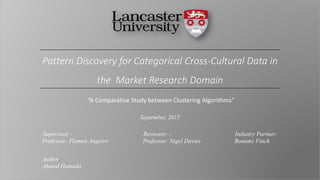
Disseration_ppt
- 1. “A Comparative Study between Clustering Algorithms” Pattern Discovery for Categorical Cross-Cultural Data in the Market Research Domain September, 2015 Supervisor : Reviewer: - Industry Partner: Professor: Plamen Angelov Professor: Nigel Davies Bonamy Finch Author: Ahmed Hamada
- 3. THE CHALLENGE Cross-cultural attitudinal segmentation studies using rating scales are seriously a challengeable tasks within the market research domain as there are a lot of shared views with fuzzy boundaries in these studies, unlike clustering on demographics. The dilemma of having meaningful clusters that can realistically reflect the respondents segments with good geometrical cluster properties is also a demanding subject in the market research domain
- 4. GAP ANALYSIS • 76% used K-means as a partitioning method for their segmentation • 93% of the segmentation studies Euclidean distance. • More 60% of the examined market research studies didn’t include an evaluation criteria for the developed clusters In a multi variate survey study, studying 243 market segmentation publications in the tourism domain (Dolnicar, 2003)
- 5. K-MEANS PROBLEMS Data Dimensionality • Distances between points become relatively uniform, therefore the concept of the nearest neighbour of a point becomes meaningless Dissimilarity Measure • it isn't just about distances, but about computing the mean. But there is no reasonable mean on categorical data Non-Convex Shaped Clusters • In Euclidean space, an object is convex if for every pair of points within the object, every point on the straight line segment that joins them is also within the object Local Minima • differentiating the objective function w.r.t. to the centroids, to find a local minimum. More paths and more initiation points can result in a global minima
- 6. EXPERIMENTS PARTITIONING METHODS HIERARCHICAL METHODS K-means K-modes ROCK Kernel K-means K-meansonrawdata K-meanson standardizedrows MCAonrawdata +K-means KernelK-meanson rawdata KernelK-meanson standardizedrows K-modesonrawdata ROCKonrawdata Euclidean Distance Matching Measure Arbitrary shaped clusters Non-convex shaped clusters 21experiments 7 X 3
- 7. DETERMINING THE NUMBER OF CLUSTERS ______________________________________________ Gap Statistic for 10 clusters _____________________________________________ Within Sum of Squares for 10 clusters ? 5, 6 & 7 Clusters Models
- 8. 7-CLUSTER MODEL GEOMETRICAL COMPARISON 117,604 87,232 1,644 283,904 224,892 0 100,000 200,000 300,000 K-means K-means on standardised rows MCA + K- means Kernel K- means Kernel K- means on standardised rows 21% 18% 59% 0.04% 0.05%0% 20% 40% 60% 80% K-means K-means on standardised rows MCA + K- means Kernel K- means Kernel K- means on standardised rows Within cluster sum of squares Cluster closeness index
- 9. INTERNAL MEASURES COMPARISON 0.102 0.05 0.09 0.08 0.07 0.125 0.05 0.1 0 0.05 0.109 0.05 0.1 0.08 0.05 0 0.1 0.2 0.3 0.4 5 clusters 6 clusters 7 clusters 0.05 0.03 -0.02 -0.01 -0.01 0.05 0.03 -0.02 0.01 0.01 0.04 0.03 -0.03 -0.01 0.02 -0.1 0 0.1 0.2 5 clusters 6 clusters 7 clusters Dunn index Silhouette measure
- 10. INDUSTRY EVALUATION Algorithm K-means on standardised rows Kernel K-means on standardised rows No. Clusters 5 6 7 5 6 7 Response Bias Freedom 1 79% 86% 79% 70% 59% 58% 2 81% 77% 67% 93% 61% 71% 3 90% 61% 79% 77% 64% 75% 4 72% 81% 71% 74% 79% 83% 5 80% 70% 75% 79% 67% 67% 6 71% 71% 61% 79% 7 71% 79% Reportability 1 71% 62% 67% 62% 76% 71% 2 38% 19% 19% 90% 24% 19% 3 19% 29% 81% 48% 81% 71% 4 43% 52% 29% 71% 33% 62% 5 62% 52% 43% 10% 33% 43% 6 71% 57% 33% 43% 7 62% 52%
- 11. 5-CLUSTERS MODEL SCATTER PLOT MATRIX FOR THE FIRST 4 VARIABLES K-means on standardised rows Kernel K-means on standardised rows
- 12. CONCLUSION 1. The results of this research revealed that the standardisation of the respondents developed better segments from the pragmatic point of view. 2. From the overall evaluation analysis, the results of the 5 clusters model using the K-means and the kernel K-means on standardised rows revealed more meaningful segments than the other methods. 3. The results illustrated that the ROCK algorithm and the application of MCA then K-means was not suitable for multiscale categorical data and resulted in meaningless clusters.
- 13. FURTHER RESEARCH • Evaluate the stability of the classification accuracy using different algorithms • Study other clustering methods available in the literature • Evaluate the same algorithms on various cross-cultural multiscale data sets and test the hypothesis whether the multi-scaled data (i.e. Likert scale) develop better clusters from the geometrical point of view. • Evaluate the clustering algorithms on a different type of response scales rather than using the multi point biased response scales
- 14. Thank You
